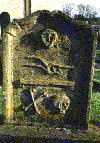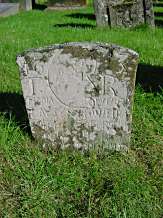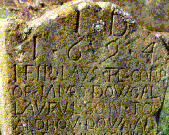

St Serf's Graveyard
|
|
|
|
Graveyards as we know them did not start until around 1600. In earlier times the space around the church was empty of monuments or gravestones, and the people of high rank and those who could pay for the privelege were buried inside the church. An act of the Scottish Parliament of 1457 decreed that in the churchyard of every parish there be held a gathering for the display and inspection of weapons four times a year, and also provision must be made for weekly arrow practice. Fairs and markets were also held in churchyards until made illegal by law in 1692. It was not so much the holding of the market in the churchyard as the holding of the market on the Sabath which caused this.

One of the outcomes of the reformation was an edict in the 1560s prohibiting burial in church and giving every man the right to be buried in his own lair in the churchyard. Burials in church continued for some time after that because it was a source of revenue for the church and the minister. However, from this evolved the graveyards as we know them today. The original lairs were marked by head and foot stones; and it was some time later, in the early 1600s, that dates and initials were carved on the headstones.
St Serf's for a small graveyard of some 500 stones has a rich collection, many showing the symbolism which was rife in the period roughly 1750-1850.
Stones to look out for:
- Two recumbent medieval stones near the church door. These are the oldest but have no distinguishing marks.
- The Rutherford stone dated 1623. This according to one authority is the oldest dated gravestone in Scotland.
- The Dowgal stone which is dated 1624.
- Stones with emblems of immortality:-
- Winged soul or cherub representing the soul leaving the body and ascending to heaven.
- Sunrays representing the Glory of God.
- Palm Fronds, Evergreens representing victory over death.
- Torches facing downwards meaning the end of earthly life.
- Heart pierced with darts meaning the death of life on earth.
- Anchor meaning a message of hope.
- Pineapple, Rosettes meaning a reminder of Heaven.
- Stones with emblems of mortality:-
- Skull, Cross-bones, Sextons' tools, Crossed darts, Hour glass.
- Stones with emblems of trade:-
- Farmer:- Plough or sock and Coulter
- Shoemake:- Cordiner's knife and crown
- Blacksmith:- Hammer and crown
- Weaver:- Loom, shuttle and weights
- Mason:- Square and compass
- Wright:- Square and axe
- Tailor:- Scissors and goose
- Ferryman:- Boat and oar.
- Cast iron grave markers. These were the product of the new skill of mass production by mould and started in the early 1800s, lasting until the 1900s. There are numerous around, but most have rusted and no longer show any names.
Back to Previous Page - Back to Top

